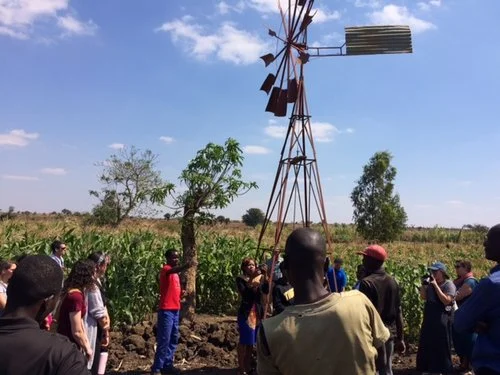Blowin’ In The Wind
You don’t always need to see a solution to know that it works. Just ask William Kamkwamba. When a severe drought caused catastrophic food shortages in the landlocked Republic of Malawi, he tapped an abundant invisible resource: wind.
Booted from school at 14 because his family could not pay $80 in tuition, young Mr. Kamkwamba took refuge in the school library. A book on wind energy spurred his imagination. "I wanted to do something to help and change things," he told CNN in 2009. "Then I said to myself, 'If they can make electricity out of wind, I can try, too.'"
Using a bicycle frame, a pulley and plastic pipes, he assembled his first tower in 2002. It powered two light bulbs and two radios in his home. Next he devised a more powerful windmill that produced enough power to pump underground water to the surface. Crops grew in dry season. Word soon traveled far in a book by Mr. Kamkwamba and former Associated Press correspondent Bryan Mealer. “The Boy Who Harnessed the Wind” rose on bestseller lists, winning attention from green power advocates and spawning an award-winning movie.
Fans of inexhaustible wind generated power will find biblical validation in Ecclesiastes. “The wind goeth toward the south, and turneth about unto the north,” scripture says. “It whirleth about continually, and the wind returneth again according to the circuits.”
Architect John Drake discovered windmills on the Texas landscape keeping crops watered. “They were everywhere,” says Kimberly Drake, John’s wife and a co-founder of the Africa Windmill Project, an NGO the couple launched in Malawi. Both are graduates of Texas Tech University and now run ecology-minded Green Apple Architecture in Winter Park, Florida.
When their nondenominational church challenged the congregation to tackle urgent global problems, Malawi beckoned. John agreed to design an HIV clinic. What volunteers discovered did not match expectations. Interviewing doctors revealed that medicine was readily available thanks to the Gates Foundation. However, AIDS patients couldn’t take the medication because their nutrition levels were too low.
Investigation exposed the underlying humanitarian threat, as the Project’s website explains:
Malawians would grow food during the “rainy season” November - February. They would grow Maize, Tomatoes, Beans, Onions and Greens using the rains that come during those months. They would harvest and store the food to last them throughout the rest of the year. During the “dry season” it was difficult to grow food using buckets to water the crops.Even if there had been no draught or erratic rainfall, families in the villages would begin running short on food. This is called the “hunger season.”
With financial support from the Summit Church and the Florida Fellowship Foundation, the Drakes along with Craig Petersen and John Parker formed the Africa Windmill Project to promote irrigation and make the hunger season history.
Photo credit: Africa Windmill Project
Because most plots are too small to support windmills, the Project has trained more than 3,000 farmers to irrigate with hand crank rope and washer pumps. Made in Malawi, easy to assemble or repair — and far less expensive to install, operate and maintain than fuel or solar-powered alternatives — hand pumps have begun to alter the agricultural landscape.
“Only the lead farmers that have gone through our training program and have the land available are able to receive windmills,” says Ms Drake. Currently, 21 lead farmers are trained and eligible. Cost, although modest by western standards, poses a significant barrier. A full size windmill has a $2,100 price tag — nearly twice the per capita income in rural Malawi. Nevertheless, Africa Windmill Project is now building its ninth windmill, says Ms Drake, with more on the drawing boards.
Mr. Gibozi Mphanzi, an African Bible College alumnus who learned to raise crops on his parents’ farm, heads the Windmill Project’s Malawi staff. Each windmill draws enough water from deep wells to irrigate an acre of crops during the dry season.
Mr. Mphanzi recently visited an early adopter. A windmill has more than doubled the farmer’s productivity by letting him harvest crops twice a year. Irrigation does more than put food on the farmer’s table. Income from increased output eases local poverty. “Farmers use the money to have people work on farms,” says Mr. Mphanzi.
It takes about four weeks to build a windmill from locally available materials. Steel frames support towers anchored in cement. Water tanks rest in sand. More of them might boost prosperity in one of the world’s poorest countries, according to The World Bank. “If we had windmills all over Malawi,” say Mr. Mphanzi, “that would really transform our economy.”



